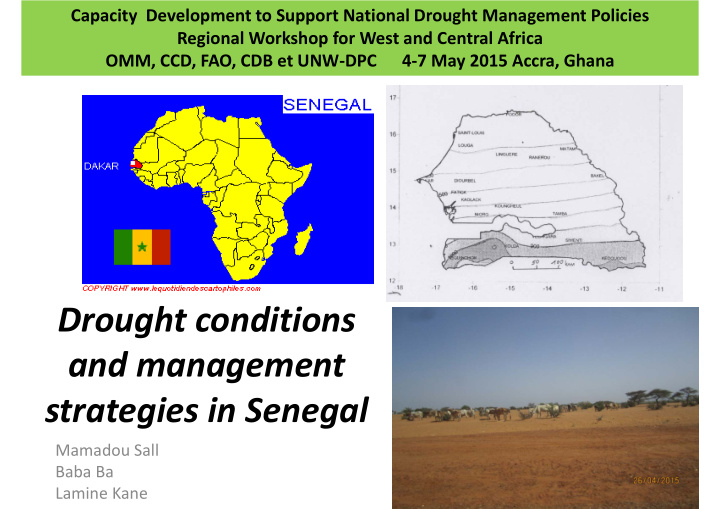



Capacity Development to Support National Drought Management Policies Regional Workshop for West and Central Africa OMM, CCD, FAO, CDB et UNW ‐ DPC 4 ‐ 7 May 2015 Accra, Ghana Drought conditions and management strategies in Senegal Mamadou Sall Baba Ba Lamine Kane
Background • Senegal: Sahelo soudanian zone • 1 Rainfall season – from May to October in the south – From July to Sept in the north • Drought manifestation: variable dry spells – rainfall shortage – poor distribution of rainfall in space and time
Drought monitoring and early warning systems : • Monitoring of: – Rainfall deficit, water level in rivers and groundwater table, soil cover condition, people migration and livestock status • Early warning systems – National Meteorological Agency (ANACIM) – Direction of water management (DGPRE) – Direction of agricultural statistics (DAPSA) – Regional institution (CILSS)
Vulnerability assessment • Agriculture sector – Loss of revenue from groundnut and vegetable production – Food insecurity due to failure of grain production – Livestock loss due to lack of natural pasture • Water supply sector – Water shortages (lake Guiers, Drying of wells) • Environment sector – disappearance of animal and vegetable species – soil cover degradation and soil erosion
Emergency relief and drought response • Actions – Food distribution for people and livestock – Compensation from agriculture insurance – Food for work in some assistance program (WFP) • Institutions – Food security commissariat (CSA) – International institutions, ONGs, bilateral cooperation
Practices to alleviate drought impacts • Development of irrigation and water harvesting projects • Agricultural research for adapted crops and efficient water use (ISRA/CERAAS) • Program safeguarding of vegetal and animal heritage (DEFCCS, DPN) • Implementation program of water boreholes in rural areas • Guideline policies for the management of drought impacts
The need for knowledge and skills on drought management • Better understanding of climate change ( impacts and mitigation measures) • Optimisation of data collection systems • Capacity of analysis of spatial and temporal data • Use of modelling tools • Design of simplified technologies of soil and water conservation • Development of innovative practices for efficient water use through the funding of research programs
Recommend
More recommend